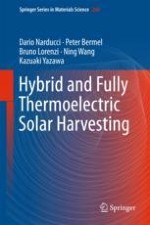This book provides a comprehensive overview on fully thermal and hybrid solar generators based on thermoelectric devices. The book fills a gap in the literature on solar conversion and thermoelectrics, because despite the growing number of papers dealing with the use of thermoelectrics in solar power conversion, no book exists for PV specialists or thermoelectricity experts to enter this field. The book is intended as a primer for scientists or engineers willing to complement their expertise in one of the two fields, and to get an updated, critical review of the state of the art in thermoelectric solar harvesting.
